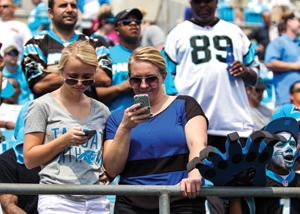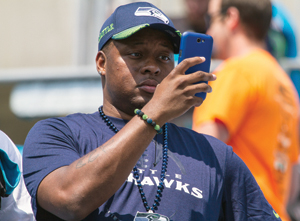Ravens at Broncos, Sept. 5
Sports Authority Field at Mile High
■ iPhone 4S / Verizon
■ Attendance: 76,977
During the second quarter, I ventured out of the press box and onto the main concourse to check out the stands. To my surprise, my iPhone 4S maintained a full five bars of service throughout the stadium, and I was able to upload photos to social media sites and text with ease.
— Fred Dreier
 |
Panthers fans check their phones at Bank of America Stadium, a venue where our reporter had success accessing the online world.
Photo by: HUNTLEY PATON
|
Seahawks at Panthers, Sept. 8
Bank of America Stadium
■ iPhone 4S / AT&T
■ Attendance: 73,294
I was able to stay connected to my smartphone from the moment I entered the stadium until the final whistle. The Panthers signed a major sponsorship last year with AT&T covering infrastructure upgrades, and the system for this year’s opener was worlds better than a preseason game last season in a half-full stadium. My phone was automatically connected to the stadium’s distributed antenna system for smartphones, which supplements traditional Wi-Fi networks. I had five bars showing at all times on my iPhone 4S and experienced no problems texting friends and tweeting photos throughout the building. Uploads were mostly instantaneous. The same thing, though, could not be said for everyone. I spoke with a Verizon customer at a concourse bar who could not connect with Instagram to send photos.
— Don Muret
 |
Some venues offer Wi-Fi; at others, fans rely on cellular service.
Photo by: HUNTLEY PATON
|
Cardinals at Rams, Sept. 8
Edward Jones Dome
■ iPhone 5 / AT&T
■ Attendance: 55,279
My iPhone 5 was in for a battle at the Edward Jones Dome. There was little trouble in the 90 minutes before the game. Once the crowd settled in for kickoff, my ability to get updates on Twitter and text a friend in the stands — in the end zone in Section 401 — was spotty. During each quarter, when I had service, I had no more than two bars on my phone. This held true no matter where I sat or stood in the dome, from the press box to field level to the concourses. The fans I spoke with in Section 401 said they’ve had similar connectivity problems in recent seasons, but it didn’t bother them much. They were there to watch a football game and cheer the Rams. Good for them.
— Christopher Botta
Bengals at Bears, Sept. 8
Soldier Field
■ iPhone 4S / AT&T
■ Attendance: 62,213
Cell service was available and running throughout the game, so I stuck with that rather than switch to Wi-Fi, which costs $1.99 or requires a subscription through provider Boingo. Early in game and on the concourse connectivity was fast, but inside the seating bowl it was slower. Most fans on their phones were in clubs or on the concourses. Halftime was the biggest trouble spot, when I dipped to three bars. Otherwise, I was showing four or five bars for the rest of the game, especially on the concourse.
— John Lombardo
Titans at Steelers, Sept. 8
Heinz Field
■ iPhone 5 / AT&T
■ Attendance: 61,585
The Wi-Fi hotspot registered a solid 9 megabits-a-second download speed at 9:45 a.m., before the fan gates opened, and a figure sufficient to support any sort of fan activity such as streaming video, photo uploading and tweeting. By noon as the stadium began to fill, that figure had fallen to 3 megabits a second, a figure where reliably streaming video becomes more difficult. By the opening kickoff, the speed test measured less than 1 megabit a second. Soon afterward, logging into the hotspot at all was difficult. Meanwhile, cellular service was OK — not lightning fast, but no major problems, either.
— Eric Fisher
Eagles at Redskins, Sept. 9
FedEx Field
■ iPhone 4S / AT&T
■ Attendance: 82,743
Cellular service was abysmal. I arrived to the stadium more than three hours before kickoff and had no problem uploading pictures to Instagram, Twitter and Facebook, or texting friends and colleagues from many places around the stadium. Two hours before the game, it was slower. And a full hour before the game it didn’t work at all. At that point, I tried sending a text with a picture from the suite level. The text didn’t go through. I spent the next hour trying to send it and had no luck. By the time I went to the concourse to send it (it went through on the fourth try), my iPhone battery was close to losing power. I had more success leaving the bowl and staying on the concourse, which meant that I had to decide whether to watch the game or get updates from elsewhere. The failure went beyond text messaging. I was unable to participate in any social media: I couldn’t upload tweets, see emails or post photos. I was cut off from any happenings away from FedEx Field.
— John Ourand
Rams at Falcons, Sept. 15
Georgia Dome
■ HTC DNA / Verizon
■ Attendance: 70,056
Both Wi-Fi and 4G were available with strong signals inside the Georgia Dome on my smartphone. An hour before the game, I connected quickly and easily to the Wi-Fi, and the signal stayed strong in the bathroom, concourse and seating areas. But once the game started, Wi-Fi was quickly overwhelmed and it became difficult to reload Twitter or Instagram. It slowed to a crawl. Many people in my section switched from Wi-Fi over to 4G and found that quicker to load mobile sites and information from their fantasy apps.
— Michael Smith
Chargers at Eagles, Sept. 15
Lincoln Financial Field
■ iPad 2 / AT&T
■ Attendance: 69,144
The Eagles’ new Wi-Fi system from Enterasys Networks is supposed to support as many as 40,000 simultaneous users. Accessing Wi-Fi means downloading the Eagles’ app, which also provides access to RedZone, camera feeds and stats with video. Making the connection was easy, and the speed was good, which was a good thing: Eagles fans have a major obsession with fantasy, and everyone seemed to be using their phones to check their players’ stats rather than watching the scoreboard for updates. Cell signal was strong throughout the game, four to five bars.
— Terry Lefton
Browns at Ravens, Sept. 15
M&T Bank Stadium
■ iPhone 4S / AT&T
■ Attendance: 71,098
Ninety minutes before the game, it took 10 minutes to post a picture to Instagram, Twitter and Facebook. That became more difficult as the stadium filled up. During the second quarter, I tried to send a text. It went through on my fifth try. By the third quarter, I had bottomed out at zero bars. It was easier to use an iPhone once I left the bowl and was on the concourse. I was generally able to communicate, even if it was slow and spotty.
— John Ourand
Buccaneers at Jets, Sept. 8
MetLife Stadium
■ Attendance: 76,957
Jets at Patriots, Sept. 12
Gillette Stadium
■ Attendance: 68,756
Broncos at Giants, Sept. 15
MetLife Stadium
■ Droid 4 / Verizon
■ Attendance: 81,285
The Jets told me that they and the Giants recently upgraded Wi-Fi. Outside of the bowl I could connect. Inside the bowl once the game started I could not. The fan next to me said he could connect, but then said he could not send texts. A trip to New England’s Gillette Stadium a few days later changed everything, though (see related story), and when I returned to MetLife Stadium the following weekend, connecting was easy and the network was fast enough to upload photos easily. I got kicked off a few times, but it was easy to get back on.
— Daniel Kaplan





